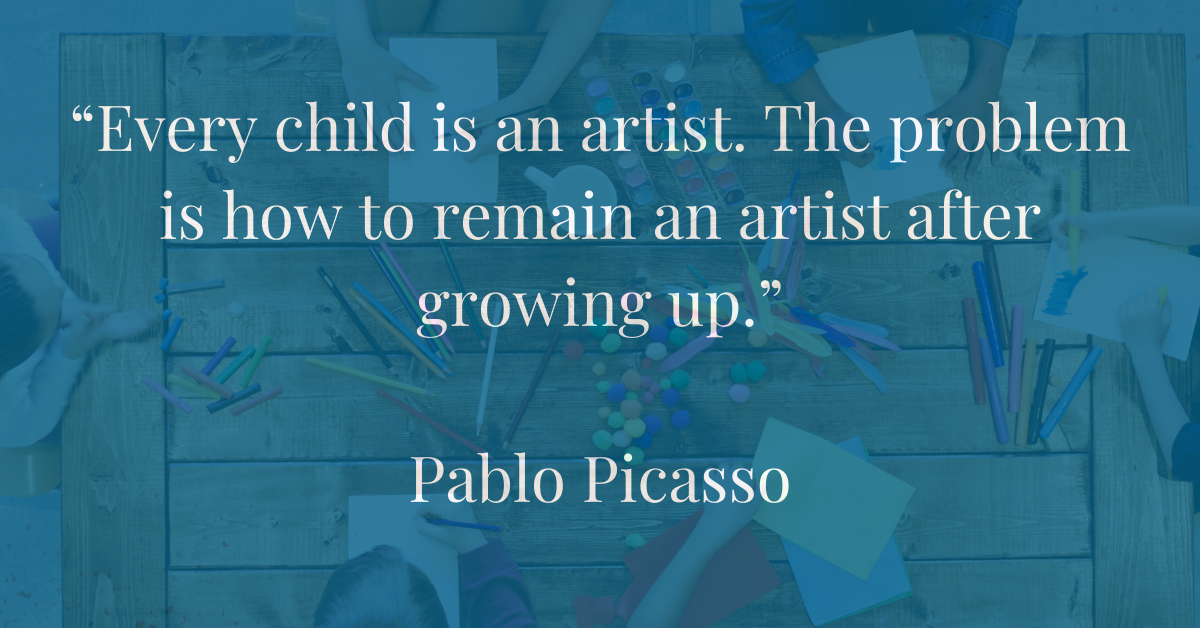
Children explore and create simply for the joy of it. They quickly notice anything new or unusual and aren’t intimidated about asking questions. Children have few doubts about themselves as inventors, storytellers and image-makers. Think about the kind of things you did as a child; inventing machines out of used chewing gum and Popsicle sticks, macramé hangers out of dental floss for your dollhouse, and dragon eggs from old bowling balls. You didn't have to be taught imagination, and you weren't afraid to try and fail. Art builds self-esteem and confidence in children because there is rarely a wrong way.
And then somehow, around the age of 10 or 12, the inner critic kicks in and we start to censor ourselves, constantly judging and editing our output. Our inborn artist gets locked in the closet, and we spend our thirties and forties trying to locate him or her by taking seminars in creative problem solving and thinking outside the box. Meanwhile, companies search desperately for designers, innovative thinkers, and gifted storytellers.
The Challenge
If Picasso is right that we are all born artists, then it's no mystery why remaining that way presents a problem. Art education is typically considered an extra or an elective, just-fun-but-you-don’t-really-need-it stuff. This viewpoint undoubtedly contributes to the steady decline of school-based arts education since 2001. The decline has been furthered by a combination of budget cuts and a curriculum skewed by high-stakes testing: all this in spite of decades of counter evidence.
The Benefits
The College Board has documented the relationship between arts education and SAT scores since 1987. A 2000 analysis showed verbal and math SAT scores of students taking any form of art to be significantly higher than for students who take no art. Students who study the arts are consistently higher academic achievers in general than students who do not. (Vaughn, K., & Winner, E. (2000)
For at-risk students the advantages are even more striking. They are three times more likely to attend college and complete a bachelor's degree, and are more civically minded, with higher levels of volunteering and voting. The arts can combat indifference, ignorance, and polarization. It is not overstating the research to conclude that art simply makes us better.
An Integrated Solution
The good news is, you don't have to be an art teacher or even artistic, to incorporate and encourage creativity. It's easy to stimulate a child's artistic imagination within everyday interactions.
“The first step,” says art teacher Brenda Ellis, “is never about teaching skills, but rather about helping children become visually aware of their surroundings. Many of us do this naturally by pointing out a landscape, a bed of flowers, observing animals, or just commenting on colors, shapes, or a person’s facial expression.” This can be accomplished across the curriculum, even in schools without formal art education.
Integration of any content area with art enhances the learning of both, as we've seen with STEM programs moving to STEAM (science, technology, engineering, arts, and math). Integration can also help address the challenge of budget cuts, and the ways in which art overlaps and overlays literature, history, science and even math makes art integration a logical enhancement.
Anna, an educator from the Santa Barbara School District was thrilled to have discovered The Art Docent Program, a digital, humanities based visual arts education program for grades K-8. The Art Docent Program takes an integrated approach to visual arts by teaching through a cultural, historic and geographic lens, while also incorporating stress reduction and social emotional learning. Students gain vocabulary, design, and literacy skills while lessons meet core standards.
"Having worked on incorporating multicultural curricula for various practical reasons, I have found that teachers often feel underprepared and uncomfortable about teaching multicultural art," says Anna. "I appreciate how The Art Docent Program encourages a more in sequential and depth integration of culture in curricula, inclusive of several key dimensions of multicultural education throughout history.
The program is cost effective, contains multi-media concepts and enhancements, and is easy to navigate on all devices. Lessons are sequenced to align with human history, starting with The Art of the Cave, and include African, Native American and Hispanic and Latin art and culture. And right now when flexibility is key, The Art Docent Program's lessons can be utilized for in-school, extended day, camp, substitute teacher, assembly, Saturday program, homeschooling, and distance learning.
During these times of conflicting social and political views, our children have never needed more direction toward the mutual respect that a multicultural curriculum fosters, and the classical enrichment to counter balance popular culture and media. In response to this need, The Art Docent Company is offering a one-month free trial subscription. Give yourself the treat of freely exploring this one-of-a-kind resource, and treat your students to both the academic and therapeutic benefits of art.
"Art enables us to find ourselves and lose ourselves at the same time."
Thomas Merton


